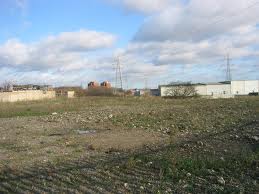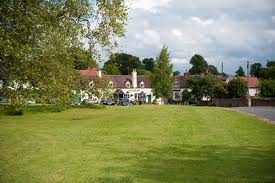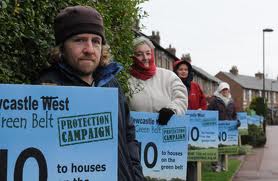
The English countryside is under serious threat, writes Camilla Scaramanga. Planning laws which protect our rural landscape have been overturned - with priority given to housing and economic growth.
‘The beauty of our landscapes, the particular cultures and traditions that rural life sustains – these are national treasures to be cherished and protected for everyone’s benefit,’ said David Cameron in 2008.1
The English countryside has been protected by planning laws since 1947. However, in 2011 ministers started pushing through plans to replace more than 1,000 pages of planning regulations with just 52 pages in the National Planning Policy Framework (NPPF). This draft legislation introduces a presumption ‘in favour of sustainable development’ and prioritizes economic growth. The consultation on the Draft Framework ended on 17 October 2011, and the Government is now working on its final draft which will be debated in Parliament this month.
The 1947 Town and Country Planning Act was created to neutralize the effects of industrialization and urbanization which had begun fifty years earlier. It sought to counteract the persistent demands of developers and to prevent the urban sprawl that blighted the landscape in the 1930’s and 1950’s. Green belts and Areas of Outstanding Natural Beauty (AONB’s) were thus established. The Act set up the condition that all development proposals apply for planning permission from local authorities. Environmental journalist Charles Clover described it as one of England’s great post-war outcomes, of equal status to the National Health Service (Countryside Voice, Planning in Chaos? p.11).
In the late 1980’s and early 1990’s, out-of-town shopping centres, such as Meadowhall in Sheffield and Lakeside in Essex, were once again destroying the landscape and leaching the character and soul from towns. In response John Gummer, the Conservative minister, and after him John Prescott, made it binding to build in the town centres, including brownfield land, first. By the late 1990’s this resulted in an area six times the size of Southampton being saved. (Jenni Russell, ‘Throwing the Countryside to the Developer Wolves’, Sunday Times, p.18, 10 October 2011).
There is undoubtedly an urgent need for affordable housing in England, augmented by the exponential rise in the population, 70 million at the last count, and rising. The Campaign to Protect Rural England has assessed that there is enough brownfield land to accommodate 1.5 million homes – much of it in the South East, where the need is greatest. This would fulfill the Government’s housing initiatives for the next six years.
However, the new policy framework eliminates the pre-requisite that brownfield sites should be built on first. Sir Simon Jenkins, chairman of the  National Trust, said this was ‘incomprehensible’ as there was so much brownfield land from England’s old industries which could be used for building. Speaking to MP’s at a Commons committee investigating the planning reforms, he said: ‘De-industrialization has yielded so much unused land – fly over it, take a train. You have got sewerage, utilities in towns. This discussion is a distraction because the fact is there are quite a few companies who want to build on the countryside and make money.’ (Christopher Hope, Whitehall Editor, Daily Telegraph 17 October 2011). By 21 December, in response to growing criticism by campaigners and a castigating report by a cross-party Commons committee, which said reforms were biased in favour of developers, Greg Clark, the Planning Minister, intimated that the NPPF may be watered down, with the brownfield policy written back in. However, this remains to be seen.
National Trust, said this was ‘incomprehensible’ as there was so much brownfield land from England’s old industries which could be used for building. Speaking to MP’s at a Commons committee investigating the planning reforms, he said: ‘De-industrialization has yielded so much unused land – fly over it, take a train. You have got sewerage, utilities in towns. This discussion is a distraction because the fact is there are quite a few companies who want to build on the countryside and make money.’ (Christopher Hope, Whitehall Editor, Daily Telegraph 17 October 2011). By 21 December, in response to growing criticism by campaigners and a castigating report by a cross-party Commons committee, which said reforms were biased in favour of developers, Greg Clark, the Planning Minister, intimated that the NPPF may be watered down, with the brownfield policy written back in. However, this remains to be seen.
Pressure from developers
Some of the Conservative Party’s biggest donors are property magnates who have been lobbying the government to alter the plans in favour of development. Last month the Daily Telegraph revealed that they had donated millions of pounds to the Government. Sir Simon said that ‘this process has seen the most intensive lobbying I’ve seen in a long time. The sums of money involved are huge’.
The Property Forum, a Tory donors’ club, has been charging influential property dealers £2,500 a year to ‘discuss current topics’ with prominent Ministers. Michael Slade, the Forum’s chairman, who has donated more than £300,000 to the Conservative Party, said in an interview in 2008 that the club has helped mould Conservative policies on construction. A spokesperson for the Conservatives retorted that the Conservative Property Forum ‘in no way influences policy’. (‘Property Developers Pay for Access to Tories’, Heidi Blake, Daily Telegraph, p.4, 10 September).
However, The Guardian obtained documents through the Freedom of Information Act which showed that the Home Builders Federation (HBF) had lobbied the Government hard to include the ‘presumption in favour of sustainable development’ in the Framework. Amongst these letters is one in which the planning minister asked the industry group to say what it ‘would like to see in the decentralization and localism bill’. The HBF said, ‘In the letter we requested that a presumption in favour of sustainable development be introduced immediately. This presumption was not our own suggestion but rather what was promised in a Conservative party Green Paper in February 2010’. The Guardian also reported that three of the four people appointed to an advisory panel on the NPPF were connected to house construction (Firms Lobbied Ministers to Relax Rules,’ Robert Booth, The Guardian, p.9, 21 November 2011).
In turn, ministers have offered £1billion worth of financial incentives to hard up councils for authorizing large building developments. (Sunday Times,  October 10, ‘Ministers are Offering £1billion in Housing Bribes’, Andrew Lainton. Also Daily Mail Online, October 10: ‘£1bn ‘Bribes’ for Councils to Push Through Developments on Greenfield Sites’, Daniel Martin). In East Croker, Somerset, the proposed development of 3,700 houses would earn the local authority £54million in grants over six years. This would prove to be a powerful enticement to cash-strapped councils. Ten other developments, including Newmarket, Durham, Harrogate and Cambridge, would give local authorities £684million over six years. A further 220 schemes are awaiting council authorization.
October 10, ‘Ministers are Offering £1billion in Housing Bribes’, Andrew Lainton. Also Daily Mail Online, October 10: ‘£1bn ‘Bribes’ for Councils to Push Through Developments on Greenfield Sites’, Daniel Martin). In East Croker, Somerset, the proposed development of 3,700 houses would earn the local authority £54million in grants over six years. This would prove to be a powerful enticement to cash-strapped councils. Ten other developments, including Newmarket, Durham, Harrogate and Cambridge, would give local authorities £684million over six years. A further 220 schemes are awaiting council authorization.
Peter Martin, an independent councillor on the Tory-led Cotswold District Council, said the payments amounted to little more than ‘bribery’. Paying for planning permission is not confined to councils. Neil O’Brien, director of Policy Exchange, a Think Tank working with Conservative policy makers which describes itself as ‘particularly interested in free market and localist solutions to public policy questions’, suggests paying off residents who are affected by development, as a more effective way to quell opposition. He wrote, ‘A big cheque in the post might prove some consolation for having development nearby’. (‘Get Paid to loosen the green belt’, Think Tank, New Ideas for the 21st Century, Sunday Times, October 10.)
Those in power have lost sight of the fact that nature cannot be measured solely in monetary terms. An analogy may be drawn with equating insurance money with the priceless personal contents of a burgled house. Earlier this year, the government introduced the National Ecosystem Assessment (NEA), which found the natural environment was worth billions to the UK economy, but omits from their calculations the quantity of beauty. The NEA also found that it provides habitats for declining species and stores carbon in the land.
If nature is reduced to fiscal merit alone, developers are handed the carte blanche, as built up land is worth more than rural land. It is unlikely to be an accident, therefore, that the NEA preceded the National Planning Framework. This assessment was initially welcomed by the CPRE, as it appeared to support local community engagement in landscape planning, and claimed ‘a commitment to the importance of landscape character, and the ‘establishment of local nature partnerships.’ It spoke of ‘the innate value of nature and our strong moral responsibility to protect it’. The claims looked promising, but all the NEA has really done is pave the way for developers.
 At the same time plans proposed by the Department for the Environment, Food and Rural Affairs (Defra) will charge communities £1,000 for applying to save their green spaces. In England there are 4,500 greens, and applications to protect them from invasive developers have increased over the last few years. Kate Ashbrook, the general secretary of the Open Spaces Society, said: ‘We are deeply concerned about the proposal to introduce fees. Many of the communities concerned with registering greens are in low-income areas, and are acting in the public interest by recording people’s rights to enjoy the land.’ A consultation document says that the fee will ensure communities are demonstrating ‘commitment’ to an application for protected status, and will ‘discourage speculative applications which stand little chance of success’. The new planning laws would simply secure the failure of such applications.
At the same time plans proposed by the Department for the Environment, Food and Rural Affairs (Defra) will charge communities £1,000 for applying to save their green spaces. In England there are 4,500 greens, and applications to protect them from invasive developers have increased over the last few years. Kate Ashbrook, the general secretary of the Open Spaces Society, said: ‘We are deeply concerned about the proposal to introduce fees. Many of the communities concerned with registering greens are in low-income areas, and are acting in the public interest by recording people’s rights to enjoy the land.’ A consultation document says that the fee will ensure communities are demonstrating ‘commitment’ to an application for protected status, and will ‘discourage speculative applications which stand little chance of success’. The new planning laws would simply secure the failure of such applications.
Critics of the NPPF suggest these moves indicate developers were key in its implementation. (Heidi Blake, Daily Telegraph, September 10). The editor of the Observer went further to say that ‘it appeared to be written by property developers’. (Observer, Editorial, 4 September).
Greg Clark, the planning minister promises that ‘presumption in favour of sustainable development’ will not over ride the green belt rules that prevent any building in the areas around the cities. Neil O’Brien goes further to declare that the government are doing nothing whatsoever to the green belt and the National Trust are guilty of irrational ‘nimbyism’. (‘Get paid to loosen the Green Belt’, Neil O’Brien, Sunday Times, October 10, 2011).
Green light for planners
However, as is evident from several cases all over the country, planning applications, which entail building on greens and countryside, are already going through. In his letter to the Sunday Telegraph on September 18, John Waine, a resident of Warwickshire, pointed out that planning inspectors are pre-empting the implementation of the rules, and under threat are ‘areas of restraint’: countryside which is not classified as officially green belt, but is the equivalent (see Strategic Gap and Green Wedge Policies in Structure Plans, 2006).
John Hobson, QC, Honorary Standing Counsel for CPRE, states that in spite of government assurances, ‘this is significant change which may weaken the protection that applies to Green Belts. If the government do indeed wish to carry forward the protection of the Green Belt to the same degree as at present, the express presumption against inappropriate development in the Green Belt should be reinstated.’ (CPRE website, October 10, 2011).
In his letter to the Sunday Telegraph Editor on September 18, John Lidstone, of Hampshire pointed out that until now, when refused, developers have reapplied for planning permission repeatedly, modifying their applications each time, with the knowledge that councils could not afford the legal cost of each planning application and would eventually have to yield. This has resulted in the unsightly developments that have marred many cities and towns. The new policy will ensure that developers win without respite. Neil Sindon, policy director of the CPPR, said ‘It’s no surprise house builders have been pushing the presumption in favour of sustainable development so strongly. It allows them to threaten local authorities with costly appeals if their applications are not approved.’ (Guardian, November 21st, p.9).
While Caroline Spellman, the Environment Secretary, promised to maintain the protection of national parks from changes in the planning laws, it now turns out that the consultation extends to National Parkland, and on November 14th 2011, more than 400 homes were approved in the South Downs. The South Downs society’s planning officer, Steve Ankers, said that they were ‘shell shocked’ by the news.
The Telegraph revealed that planners had been told to go ahead with approving developments based on the NPPF, long before the consultation and framework was supposed to be finalized (‘New planning laws already in force’, Daily Telegraph, p. 1, September 7). As early as August 30th, the advice published on the Inspectorate’s website stated, ‘The Draft NPPF is likely to be referred to by the parties in current appeal and development plan casework. ‘Whilst it is a consultation document and, therefore, subject to potential amendment, nevertheless it gives a clear indication of the Government’s ‘direction of travel’ in planning policy’.
Mr Osborne considers the Framework an expedient salve to the country’s economic malaise, but the government need only look at the disastrous consequences of unregulated planning laws in Ireland, Spain and Greece. Dame Fiona Reynolds of the National Trust points out that these countries all went under economically. The desecrated beauty of Southern Ireland affords a stinging sample of liberalized planning laws, codified in Ireland’s Sustainable Rural Housing Guidelines (2005). By the time the property bubble burst in 2008, the once majestic countryside was littered with ugly, rapidly erected houses which no one could afford, and ‘ghost estates’ of unfinished houses that were abandoned by insolvent developers.
Tourists who visited Ireland for its natural beauty will now look elsewhere for aesthetic succour. Ministers need to learn that the economy can thrive in tandem with nature, rather than at its expense.
 In his bid to solve the source of rioting in urban youth, Mr Cameron should think twice about concreting over the countryside. In his article arguing for more green spaces in cities, (Guardian, 9 August, 2010), George Mombiot cited a series of studies beginning in San Francisco in 1969, showing a direct relation between the absence of greenery and property crime and violent crime. (F. E. Kuo and W.C. Sullivan, May 2001. Environment and Crime in the Inner City: Does Vegetation Reduce Crime? Environment and Behaviour vol. 33 no. 3 343-367 doi: 101177/0013916501333002).
In his bid to solve the source of rioting in urban youth, Mr Cameron should think twice about concreting over the countryside. In his article arguing for more green spaces in cities, (Guardian, 9 August, 2010), George Mombiot cited a series of studies beginning in San Francisco in 1969, showing a direct relation between the absence of greenery and property crime and violent crime. (F. E. Kuo and W.C. Sullivan, May 2001. Environment and Crime in the Inner City: Does Vegetation Reduce Crime? Environment and Behaviour vol. 33 no. 3 343-367 doi: 101177/0013916501333002).
Other studies revealed that trees influence people’s use of communal spaces, encouraging them to spend more time there amongst others, which leads to stronger social bonding. (R. L. Coley, F. E. Kuo and W. C. Sullivan, 1997. Where does Community grow? The social context created by nature in urban public housing. Environment and Behaviour, 291 468-492). Professor Jules Pretty, of the Centre for Environment and Society at the University of Essex, said that studies had found just looking at greenery had a beneficial effect, lowering blood pressure and improving health. (FT, June 6 20005).
Nature is a natural palliative to the mind and soul and the goodness it imparts is beyond words and without a price. We would do well to observe the Buddhist precepts of oneness with the environment. According to Buddhism, everything around us is a reflection of our inner lives, and there is in truth no separation between ourselves and the world. If the inner state is one of turmoil and negativity, and if we are motivated by greed and selfishness, the impoverishment of our ecosystem would be inevitable . Nichiren Daishonin wrote, ‘If the minds of the people are impure, their land is also impure but if the minds are pure, so is their land. There are not two lands, pure and impure in themselves. The difference lies solely in the good or evil of our minds.’ By ‘evil’, he meant the self-centred characteristics born of such qualities as greed and arrogance. If we were connected to our intrinsic nature, the preservation of our natural environment would be automatic.
The current overtures are a far cry from the new Conservative rejection of Thatcher’s values of the 80’s. The memory of a pre election Cameron parading about his solar powered house or pedaling to and fro on his bicycle, limo in tow, is all the more incongruous, given the environmental havoc his party is now wreaking, in the name of the economy. In 2010 the Conservatives introduced the Public Bodies Bill, which gave Caroline Spellman, Secretary of State for Environment, Food and Rural Affairs, powers to sell land held by the forestry commission. By February, 2011, due to widespread protest, the government had backed down from their proposal to sell off 258,000 hectares of English forestry estate. A You Gov poll found 84% of people were against the privatisation, and 38 Degrees had collected 533,138 signatures on their petition.
However, Conservatives have continued Labour’s plans to build a new £32 billion high-speed railway from London to the Midlands, which will cut through and destroy the beautiful Chilterns, an area of outstanding natural beauty, amongst other places. All to shave thirty minutes off a train journey, and thus boost the economy no end. The government has already spent £200 million, and is due to spend £1 billion on the HS2 before it has even begun construction. What rationale deems that a shorter train journey for a relatively small number of passengers could justify these costs?
In 2005, Oliver Letwin, the then shadow environment secretary, gave a speech entitled ‘Politics as if beauty mattered’. This argued for the need to make the environment beautiful because ugliness depleted the soul. He said, ‘The beauty of our natural and built environment has an objectively measurable effect on our well-being’, and ‘To live surrounded by what one finds ugly is to live a deprived life.’ If the NPPF goes through in its current form, we and generations to come will be deprived of what is arguably England’s richest asset. The countryside is what Churchill reportedly explained his country was fighting for in WWII. The one place to recover a sense of self, a sense of truth, is in nature. There is no evil, no crime, no darkness or subterfuge within it. If, like Churchill, Mr Osborne were to take up landscape painting, be still and observe the beauty of what is around him, he may obtain an inkling of what spurs environmentalists everywhere.
Joining the campaign
 There is a strong force of opposition to these plans. Up and down the country, local communities have joined forces against proposed developments. In Great Cornard, Suffolk, for example, residents mounted a furious protest against the proposed building of 170 houses. Several organizations have campaigned against the NPPF, including the National Trust, the National Federation of Women’s Institutes, Friends of the Earth, the Campaign to Protect Rural England, and the ‘Hands off our Land’ campaign run by the Daily Telegraph. On 20 December, a Cross-Party Committee produced a report on the plans, concluding that the NPPF was biased in favour of developers. (Cross-Party MP’s committee tells the Government to draw up a new NPPF, Daily Telegraph, 20 December 2011). Clive Betts, the Chairman of the Communities and Local Government Select Committee, said the reforms were ‘weighted to economic development at the expense of social and environment factors’ (Daily Telegraph, 22 December, 20ll).
There is a strong force of opposition to these plans. Up and down the country, local communities have joined forces against proposed developments. In Great Cornard, Suffolk, for example, residents mounted a furious protest against the proposed building of 170 houses. Several organizations have campaigned against the NPPF, including the National Trust, the National Federation of Women’s Institutes, Friends of the Earth, the Campaign to Protect Rural England, and the ‘Hands off our Land’ campaign run by the Daily Telegraph. On 20 December, a Cross-Party Committee produced a report on the plans, concluding that the NPPF was biased in favour of developers. (Cross-Party MP’s committee tells the Government to draw up a new NPPF, Daily Telegraph, 20 December 2011). Clive Betts, the Chairman of the Communities and Local Government Select Committee, said the reforms were ‘weighted to economic development at the expense of social and environment factors’ (Daily Telegraph, 22 December, 20ll).
In September, the National Trust drew up a petition against the Framework, which was signed by 250,000. Given that the final drafting of the NPPF is expected this month, and the final version is due in April, now is the time for persuading ministers to amend it. It is possible to contact the planning minister, Greg Clark, at the Department for Communities and Local Government (the website is communities.gov.uk). He is still listening to people’s responses to the NPPF. You can write to or e-mail your MP, or lobby them in person at the Houses of Parliament. MP’s have been receiving a lot of e-mails and letters, and many of them have been following these up by writing to and meeting the Ministers responsible for the NPPF. Even though the public consultation has closed, MP’s still have a route through to Ministers, and their input could yet be influential, given that the framework has not been finalized.
1.David Cameron in his 2008 address to the Campaign to Protect Rural England.
